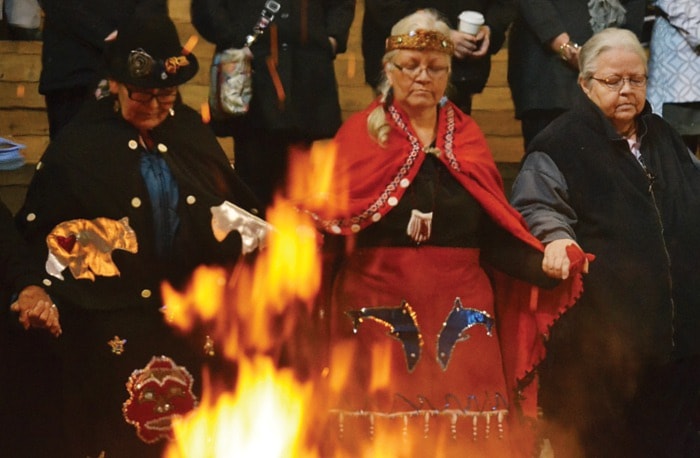Smoke and sunshine intertwine at the top of the Kwanwatsi Big House.
The smoke represents healing.
The sunshine is hope.
The smoke is on its way out, the burned remains of terrible residential school memories.
The sunshine, a single brilliant ray illuminating one of the four carved house posts, brings reassurance and faith.
This is a unique gathering of First Nations bands from across Northern Vancouver Island, residential school survivors, their families and more than 100 local high school students.
On Monday afternoon, they’ve come to the big house on the Campbell River Indian Band Reserve to begin a healing process and to remember those who passed on and were never able to fully recover.
Some, like James Quatell, 63, and Trudy Smith, 55, have spent a lifetime trying to heal.
“I came back here in 1962 and now it’s 2012. I finally have that feeling of being welcomed back home. I’ve been waiting for this for a long time,” says Quatell, who was taken from his family in Campbell River when he was 10 years old and spent the next four years at the residential school in Alert Bay.
“When I came back, it was like I was a stranger…it was like I had the plague.”
Smith was just a Grade 2 student in Port Alberni when she was forcibly removed from her family and sent to the residential school on Kakawis Island near Tofino.
“I was taken away in 1965 and lost everything, language, culture, my family…” she recalls of six horrific years on the island. “When I came home, my mom collapsed when she saw me. (My parents) were told I didn’t exist. They lived in fear and isolation just like me.”
As a child, Smith didn’t understand why the nun would come into the dormitory at night and lead one of the other girls away. And then it was her turn to be sexually assaulted and beaten.
“A Sister abused me right away…I was sexually abused for years,” she says softly.
Somehow, Smith found an inner strength to shelter the younger girls arriving at the school. She would take their place to suffer more sexual and physical abuse.
“I would fill in for them, take the beatings and take the pain for them. I didn’t want them to be touched. I was protecting them.”
For Smith and Quatell, this day of healing brought back painful memories, but they’re glad to be here, especially with all the young people attending. It’s important for them to understand what their parents and grandparents went through.
“I thank the Creator they didn’t have to go through what we did,” says Quatell.
Today, Quatell is a cultural leader and one of the organizers behind this healing process called “Imagine Campbell River.” But it took years before he was able to fully re-embrace his culture.
That happened in 1993, when the Campbell River Indian Band launched their 45-foot-long canoe, the first ocean-going canoe to be carved locally in more than 70 years.
“That canoe was a unique gift,” he says. “Up until then, I felt like an outcast…when I came back (from residential school) I didn’t want to be First Nations. There was a battle within myself and I fought like hell.”
The bitter memory fades from his eyes and the warm smile returns as Quatell reflects on this afternoon of healing. The students have learned the importance of the traditional First Nations village where people take care of each other, as well as resiliency.
“We need to move forward and let the country move forward,” says August Johnson, a member of the Homalco First Nation.
The healing will continue Thursday and Friday, next door at the Thunderbird Hall when the survivors come forward to tell their stories during the “Truth and Reconciliation” process. Smith will tell her story and so will Quatell.
“It’s so sad for those who’ve never had these feelings of being welcomed back,” he says. “The voice I’m speaking with isn’t blaming, it’s what I feel.
“Some people call it healing, I call it my voice.”
As the day comes to a close, everyone gathers around the fire at the centre of the big house. On pieces of paper, each writes a sentence or two of things they want to leave behind.
The papers are gathered and collectively burned. Then, they write some more, of things they want to reclaim for their community. These are placed in the Gildas treasure box.
“We leave today committed to our new path of healing,” Kathi Camilerri tells the group. “Love, kindness, respect and generosity, these are things that help us heal.
“This is how we’ve healed forever.”
The bitter memories have gone up in smoke and now the participants gather around the dying fire to say a prayer at the day’s end.
A peaceful calm comes over Darren Matilpi as he gets up to join hands in the circle.
“Powerful healing took place here today,” he says.
paulr@campbellrivermirror.com
